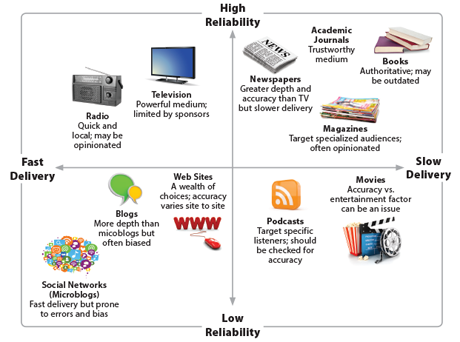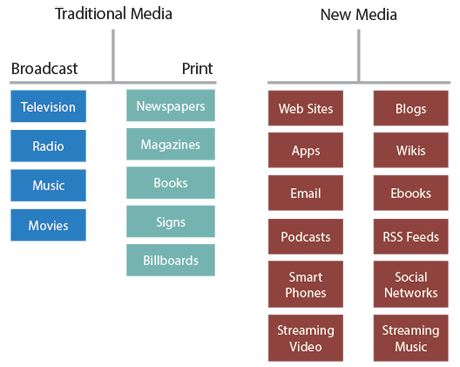246
Medium: What type of media is used to deliver
the message?
Media types fall under two broad categories: traditional and new. The traditional media include the print and broadcast formats, while the new media include the ever-changing digital formats, such as blogs and podcasts.
Not so long ago there existed a clear distinction between the two categories. Today, they are evolving closer together. Traditional media have begun to embrace the interactive, adaptable, and social nature of new media, while new media are boosting their reputation as outlets for hard news. In fact, journalists often break new stories on Twitter before they appear on television or in a newspaper. As technology advances, traditional media and new media will resemble each other even further.
Explore the graphic below to better understand the types of media.
Types of Media
Your Turn
- What types of media do you use most frequently? How are your media preferences similar or different from your parents’ media preferences?
- Twenty years ago, digital media didn’t exist. How did people get their news back then? Consider the options for getting news today. Discuss with a classmate the relative strengths and weaknesses of news-delivery methods before and after the digital age.
247
Medium: What are the strengths and
weaknesses of the media format?
Each media format has inherent strengths and weaknesses. Social media messages, for example, are quick and efficient but prone to inaccuracies. In general, newspapers provide depth and accuracy but lack the sensory appeal of television, the interactive feature of a blog, and the rapid delivery of radio.
|
Format
|
Strengths
|
Weaknesses
|
|
Web sites, blogs, microblogs
|
Accessible; interactive; diverse; immediate; inexpensive
|
Prone to inaccuracies; often biased and opinionated
|
|
Newspapers, magazines, books
|
Accurate; comprehensive; appeal to general public
|
Limited to text and pictures; slow delivery
|
|
Television, radio
|
Strong audio and visual appeal; current; local; friendly
|
Highly commercialized; highly persuasive; may be biased
|
Finally, consider the graphic below that compares various media by plotting the general reliability of the information against delivery speed. 


